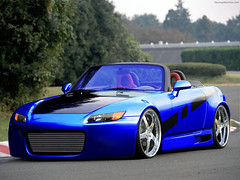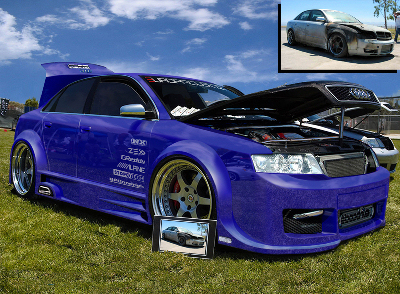
Diablo was launched in 1990 as successor to the legendary Countach. It was developed under the investment from Chrysler which bought Lamborghini in 1987. With more money, no wonder the Diablo was better developed than any other previous Lamborghini. Eventually, it survived for 11 years and 2884 cars were built, breaking the record held by Countach. The name Diablo means "Devil" in Spanish (not Italian). Like Countach and many other Lamborghinis, it was designed by Italian styling maestro Marcello Gandini. No wonder the car had strong resemblance to its predecessor, such as slant front end, steeply raked windscreen and scissors doors. However, the final design was refined by Chrysler's studio in the USA, smoothened all sharp edges and corners, improved cooling and aerodynamics. In the end, it was changed so much that Gandini was displeased and decided to realize his original design in another supercar, Cizeta Moroder V16T.
However, it is undeniable that the Chrysler-refined Diablo was prettier and more enduring than the Cizeta. It looked pure yet aggressive, futuristic yet matured. Chrysler's attention to details complemented what Gandini infamous of. Most important was that it looked truly exotic, which was exactly what contemporary supercars lack of - McLaren F1 and Jaguar XJ220 might look sexy, but not aggressive and dramatic enough. The Lamborghini was different. Its styling meant velocity, acceleration and power. Even in standstill, its appearance told you it was a 200mph supercar, no, perhaps 250mph ! If you let me name the most successful supercar design during the 1990s, Diablo will always be the first one I would think of.However, technology-wise, Diablo was just an extension of Countach. When the Countach was launched in the early 70s, its spaceframe chassis, aluminium body and transmission layout were rather advanced. Entered the late 80s, Porsche 959, Ferrari GTO and F40 started a supercar revolution by using lightweight construction, twin-turbo engines and space-age carbon-fiber materials. In contrast, the Diablo still rested on the laurel of Countach without any significant changes. The chassis, body and the big V12 were just evolution from the old one. And unsurprisingly, it gained more length, width and wheelbase as well as a touch more (desperately needed) cabin space. As a result, a standard Diablo tipped the scale at more than 1600kg, about 130kg heavier than the last Countach.
If you let me name the most successful supercar design during the 1990s, Diablo will always be the first one I would think of.However, technology-wise, Diablo was just an extension of Countach. When the Countach was launched in the early 70s, its spaceframe chassis, aluminium body and transmission layout were rather advanced. Entered the late 80s, Porsche 959, Ferrari GTO and F40 started a supercar revolution by using lightweight construction, twin-turbo engines and space-age carbon-fiber materials. In contrast, the Diablo still rested on the laurel of Countach without any significant changes. The chassis, body and the big V12 were just evolution from the old one. And unsurprisingly, it gained more length, width and wheelbase as well as a touch more (desperately needed) cabin space. As a result, a standard Diablo tipped the scale at more than 1600kg, about 130kg heavier than the last Countach.
















No comments:
Post a Comment